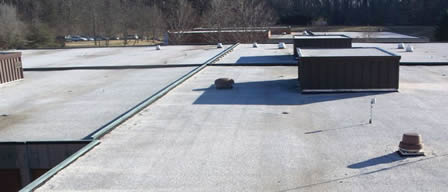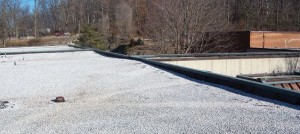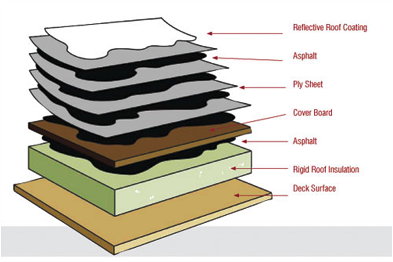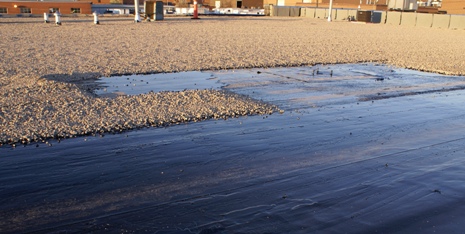 Built-up roofing has been used for more than 100 years and is extremely durable. That’s becoming more apparent over time. BUR offers the added protection of redundant multiple layers, performs well in extremes of heat, cold, wind, and snow, is easy to repair, and has a proven track record. One perception with BURs is the smell that is often associated with this type of material. Recent innovations have made it possible for some products to reduce up to 90 percent of asphalt fumes at the kettle. This enables the contractor to schedule odor-sensitive jobs during typical business hours. BURs simply last longer. By using an ultra long lasting product, you could be adding five to 10 years of life to your roof. That’s hugely beneficial when you calculate your roof life-cycle cost. Quality asphalt today is much the same as the high-quality asphalt that was used by past generations of roofers. Asphalt has always been a good product, which is how it earned its reputation. In common with many industries, quality control is better today, and users are assured of receiving a high-quality product whose properties are more tightly monitored and controlled. Also, there are more choices with regard to asphalt that has been modified with polymer additives. These additives can be used to impart UV protection to the asphalt – for example, when the asphalt is used for a flood coat – or to adjust the melt point and viscosity, depending on the ambient temperature or roof slope, or to adjust the elasticity of the asphalt.
Built-up roofing has been used for more than 100 years and is extremely durable. That’s becoming more apparent over time. BUR offers the added protection of redundant multiple layers, performs well in extremes of heat, cold, wind, and snow, is easy to repair, and has a proven track record. One perception with BURs is the smell that is often associated with this type of material. Recent innovations have made it possible for some products to reduce up to 90 percent of asphalt fumes at the kettle. This enables the contractor to schedule odor-sensitive jobs during typical business hours. BURs simply last longer. By using an ultra long lasting product, you could be adding five to 10 years of life to your roof. That’s hugely beneficial when you calculate your roof life-cycle cost. Quality asphalt today is much the same as the high-quality asphalt that was used by past generations of roofers. Asphalt has always been a good product, which is how it earned its reputation. In common with many industries, quality control is better today, and users are assured of receiving a high-quality product whose properties are more tightly monitored and controlled. Also, there are more choices with regard to asphalt that has been modified with polymer additives. These additives can be used to impart UV protection to the asphalt – for example, when the asphalt is used for a flood coat – or to adjust the melt point and viscosity, depending on the ambient temperature or roof slope, or to adjust the elasticity of the asphalt.
The introduction of modified-bitumen membranes has helped to boost the image of asphalt roofing as a high-tech roofing system. There are also cold-applied BUR systems, which use polymer-modified bitumen in the place of hot asphalt. Other innovations are the use of reflective granules and white cap sheets, and polymer products with a fleece back that can be fully adhered in asphalt.
 The introduction of modified-bitumen membranes has helped to boost the image of asphalt roofing as a high-tech roofing system. There are also cold-applied BUR systems, which use polymer-modified bitumen in the place of hot asphalt. Other innovations are the use of reflective granules and white cap sheets, and polymer products with a fleece back that can be fully adhered in asphalt. The strength and redundancy of the original BUR is due to the fact that asphalt is an ideal roofing adhesive, which forms a strong waterproof bond between two surfaces. Nothing else compares. So even as new membranes are being developed, they are still installed in asphalt for best performance.
The introduction of modified-bitumen membranes has helped to boost the image of asphalt roofing as a high-tech roofing system. There are also cold-applied BUR systems, which use polymer-modified bitumen in the place of hot asphalt. Other innovations are the use of reflective granules and white cap sheets, and polymer products with a fleece back that can be fully adhered in asphalt. The strength and redundancy of the original BUR is due to the fact that asphalt is an ideal roofing adhesive, which forms a strong waterproof bond between two surfaces. Nothing else compares. So even as new membranes are being developed, they are still installed in asphalt for best performance.
Environmental issues will be a big factor in how BUR systems will be perceived in the future. The educated and qualified roofing community still believes that BUR systems are the best applications and also the best in relation to total acquisition cost. Unfortunately, the people who will set the regulations that govern our industry don’t know or care about the fact that BUR systems are the proven “Grand Daddy” in commercial roofing systems. Alternate applications; combining BUR with other technologies (i.e., cold applied, combining BUR with atactic polypropylene [APP], styrene butadiene styrene [SBS] or even thermoplastic polyolefin [TPO]); and energy-efficient BUR systems and systems that allow less asphalt to be used.
Many products are made from petroleum as a raw material, so increasing oil prices have about the same impact on asphalt roofing as any other industry. In some cases roofers may try to cut costs by choosing options that use less asphalt; for example, by opting for a cap sheet instead of a flood coat. However, recent cost pressures on asphalt have had little effect on overall installed cost of these systems to building owners. Generally, the cost of asphalt remains a small percentage of total installed cost when labor costs are included in the calculations. So, from the building owners perspective, an asphalt BUR is still a high-value roofing system.
The one thing that many building owners still need to understand is that, although initial costs of a BUR may appear to be higher than other roof systems, the long term costs are less for a BUR, which can last for decades. The beauty of an asphalt BUR is that the redundancy of layers provides some insurance against installation defects. A high-quality asphalt BUR with no serious installation defects is extremely durable and can survive for decades. Peak roof temperatures, roof traffic, and type of gravel or cap-sheets can also be factors. It is difficult to put a price on the loss of business that is due to the interruptions of commerce. Significant business losses can occur when a roofing system needs to be replaced after 10 years rather than 20 or more years. Such “invisible” or “intangible” losses are seldom included in life-cycle analyses, but they matter a lot to building owners.
One of the greatest benefits of multi-ply asphaltic systems is the long history of successful leak-free installations. While the initial installation costs may appear to be less with some single-ply systems, the hassle-free performance of multi-ply asphaltic systems pays off in the long term. Quality installation starts with selecting contractors trained and certified by the chosen manufacturer. Guaranteed jobs, inspected prior to the issuance of the manufacturers’ guarantee, are also the best way to begin.
In some instances BUR roofs will need to be coated with white roof coatings or will need a reflective white cap sheet to meet the requirements for cool roofs. The addition of these materials adds to the cost of a BUR roof system and could have a negative impact on BUR demand. However, cool roof requirements allow a tradeoff of additional insulation instead of applying a white roof. The insulation tradeoff allows you to continue to use a black BUR roof and still meet the requirements. Tradeoff options, such as additional insulation, can provide a cost-effective alternative for customers and allow them to collow them to continue to use and enjoy the reliability, durability, and proven field performance provided by BUR systems. The cool roof movement has already impacted the BUR market. Manufacturers have responded with energy-efficient cap sheets and coatings to assure compliance with today’s stringent requirements.
Today’s BUR systems can be installed with minimal impact on the building occupants by following a few standard practices. Odors created during the installation of a BUR system can be mitigated by using low-fuming asphalt or by using equipment that reduces or eliminates asphalt fume emission from the kettle. Other methods for controlling asphalt odors include keeping the asphalt kettle away from building air intake handling units and by properly following the kettle equipment manufacturer recommendations.
Materials and system description
 BUR systems generally are composed of alternating layers of bitumen and reinforcing fabrics that create a finished membrane.
BUR systems generally are composed of alternating layers of bitumen and reinforcing fabrics that create a finished membrane.
The number of plies in a cross section is the number of plies on a roof: The term “four plies” denotes a four ply roof membrane construction. Sometimes, a base sheet, used as the bottom, is mechanically fastened. Built up roofs generally are considered to be fully adhered if applied directly to roof decks or insulation. The reinforcing fabrics also are called roofing felts or ply sheets. Roofing felts are reinforced with either glass-fiber mats or organic mats. Felts are produced in a standard width of 36 inches and metric width of about one meter. The bitumen typically used in BUR roof systems is asphalt, coal tar or cold-applied adhesive. The asphalt or coal tar is heated in a kettle or tanker and then applied by mop or mechanical spreader. Asphalt is a petroleum product refined from crude oil; coal tar is derived from the distillation of coal. Cold-applied adhesives typically are solvent-based asphalts that don’t have to be heated in a kettle or tanker. Surfacing for built up roof systems usually include aggregate (such as gravel, slag or mineral granules), glass-fiber or mineral surfaced cap sheets, hot asphalt mopped over the entire surface, aluminum coatings or elastomeric coatings.
Warranties
When purchasing a new roof system, there will be two warranties to consider. First, there will be the manufacturer’s warranty. In general, these warranties cover defects in the manufacture of the roof membrane. Once the project is complete, be sure the contractor provides you with a certificate for your records. Second, the roofing contractor will provide you with a warranty covering his workmanship. Typically, this will cover installation and related issues. The warranty should contain what items are covered and what will void them. Many contractors offer one year or two years of coverage; however, there is no industry standard.

